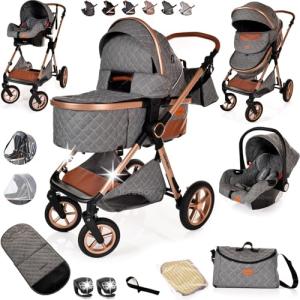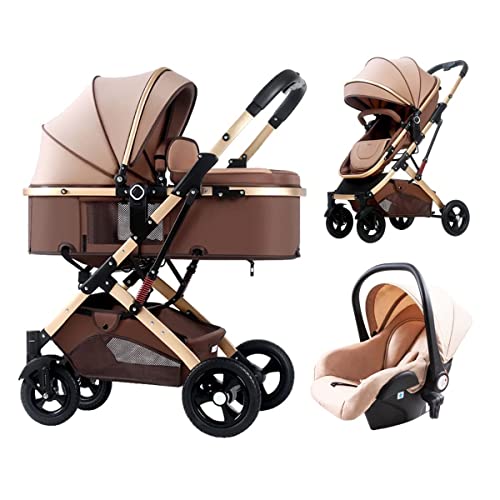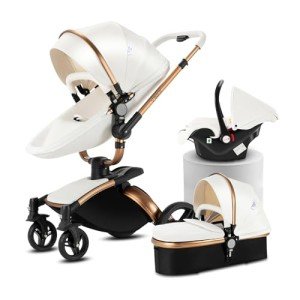When you’re bringing home your little one, a good pram makes all the difference. Our selection of prams for newborns combines comfort, safety, and style so you can stroll with peace of mind. With features like adjustable seats, cozy carrycots, and smooth maneuverability, you and your baby will be ready for any adventure together.
Prams For Newborns
High-quality prams designed specifically for your newborn baby
Product List

Lightweight 3-in-1 Travel System
Boneelook
Product Review Score
4.8 out of 5 stars
156 reviews$226.32

Brown 3-in-1 Stroller Travel System
Product Review Score
4.33 out of 5 stars
111 reviews$361.56 $321.40

White 3-in-1 Travel System
Magic Zc
Product Review Score
4.22 out of 5 stars
201 reviews$514.21 $437.06
When welcoming a new member into the family, one of the essential purchases that parents must make is a pram. Prams not only provide a safe place for the baby to rest while on the go, but they also make outings much easier for new parents. With a wide array of options available in the market, choosing the right pram for a newborn can be a daunting task. This comprehensive guide will simplify this process, breaking down various types of prams, key features to consider, and answering frequently asked questions.
Types of Prams
When selecting a pram for a newborn, it is essential to understand the different types available:
| Type | Description | Age Suitability |
|---|---|---|
| Traditional Pram | A classic, fully reclining design that allows newborns to lie flat. Perfect for early months. | Newborn to 6 months |
| Travel System | Combines a car seat and a stroller, allowing for easy transfer from vehicle to pram. | Newborn and up |
| Compact Stroller | Lightweight and foldable; convenient for parents on the go, but may not fully recline. | 3 months and up |
| Twin Pram | Designed for twins or siblings close in age, with side-by-side or tandem seating. | Newborns and up |
| Jogging Stroller | Built for active parents, with larger wheels and a sturdy frame for a smooth ride. | 6 months and up |
Key Features to Look For
When selecting the right pram for your newborn, consider these essential features:
-
Safety Standards: Ensure the pram complies with safety regulations. Look for prams with a strong frame and secure harness system.
-
Reclining Seat: A fully reclining seat allows the newborn to lie flat, essential for their spinal development and comfort.
-
Suspension System: A quality suspension system provides a smoother ride over bumpy terrain, which is vital for the baby’s comfort.
-
Weight and Portability: Consider how heavy the pram is and how easily it folds. Lightweight options are easier to maneuver and transport.
-
Storage Space: Look for prams that come with ample storage baskets or compartments for baby essentials.
-
Weather Protection: A pram with a large canopy provides protection from sun and rain. Some might even have extendable canopies for additional coverage.
-
Adjustable Handlebar: This feature makes it easy for parents of different heights to comfortably push the pram.
-
Durability: Invest in a pram made from high-quality materials to ensure longevity.
Comparing Popular Prams
To help narrow down the options, here’s a comparison of some of the most popular prams for newborns:
| Pram Model | Type | Weight | Price Range | Key Features |
|---|---|---|---|---|
| Bugaboo Cameleon 3 | Traditional Pram | 21 lbs | £900-£1,200 | Fully recline, customizable fabrics, strong suspension |
| Chicco Bravo Quick-Fold | Travel System | 21 lbs | £300-£350 | Stroller & car seat combo, easy one-hand fold |
| Baby Jogger City Mini GT2 | Compact Stroller | 20 lbs | £400-£500 | All-terrain wheels, adjustable handle, one-hand fold |
| Joovy Twin Roo+ | Twin Pram | 30 lbs | £200-£250 | Compatible with two car seats, lightweight, affordable |
| BOB Revolution Flex 3.0 | Jogging Stroller | 28 lbs | £500-£600 | Smooth ride, large storage basket, adjustable handlebar |
Frequently Asked Questions (FAQs)
1. What is the best pram for a newborn?
The best pram for a newborn is one that offers a fully reclining seat, good stability, and safety features. Traditional prams with a flat recline are often recommended for the youngest infants.
2. Can I use a stroller for a newborn?
Many strollers can be used for newborns, especially if they have a fully reclining feature. Travel systems that include an infant car seat are also ideal options.
3. What’s the difference between a pram and a stroller?
A pram is designed specifically for infants and typically features a flat, fully reclining seat. A stroller, on the other hand, can accommodate older babies and usually has a more upright seating position.
4. How long can I use a pram?
Most prams can be used until your child weighs around 50 lbs or is tall enough that they can no longer sit comfortably. This typically means 4 to 6 years of age, depending on the model.
5. Are more expensive prams worth it?
Higher-priced prams often offer enhanced safety features, materials, and durability compared to lower-priced models. However, finding a pram that fits your needs and budget is essential.
Choosing a pram for a newborn is a significant decision that influences both the baby's comfort and the parents' convenience. By understanding the types of prams available, their features, and comparing popular models, parents can make an informed choice that suits their lifestyle. Regardless of the choice made, investing in a safe, comfortable, and functional pram will certainly make outings with the newborn enjoyable and stress-free. Happy strolling!
This guide aims to assist parents in navigating the diverse market of newborn prams, helping them make a choice that meets both their practical needs and the needs of their little ones. Whether it’s a traditional pram, a travel system, or a compact stroller, there’s sure to be a model that perfectly fits your family's lifestyle.